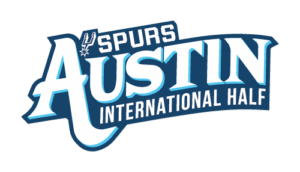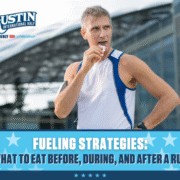Fueling Strategies: What to Eat Before, During, and After a Run
When you’re preparing for the Austin International Half, your nutrition plan can be just as important as your training schedule. The right fueling strategy will help you maintain steady energy levels, avoid mid-race slumps, and recover faster so you can get back to training (or celebrating) feeling strong. Let’s break down what to eat before, during, and after your run to set yourself up for half marathon success.
 Before Your Run: Prime Your Energy Tank
Before Your Run: Prime Your Energy Tank
The goal here is to top off your glycogen stores—the body’s preferred fuel source for endurance exercise—while keeping your stomach comfortable.
-
The night before: Stick to a balanced dinner with complex carbs, moderate protein, and minimal fat. Think grilled chicken, roasted sweet potatoes, and steamed veggies.
-
2–3 hours before your run: Eat a carbohydrate-rich meal that’s easy to digest. Oatmeal with banana and honey, whole-grain toast with peanut butter, or a bagel with jam are great choices.
-
30–60 minutes before: If you need a quick boost, go for a light snack like a banana, energy bar, or a few pretzels. Avoid high-fat and high-fiber foods—they can slow digestion and cause discomfort.
Pro tip: Practice your pre-run meals during training, not race day, so your stomach knows exactly what’s coming.
 During Your Run: Keep the Fuel Flowing
During Your Run: Keep the Fuel Flowing
Once you pass the one-hour mark, your body starts to deplete its glycogen stores, so mid-run fueling becomes key.
-
Timing: Aim to take in 30–60 grams of carbohydrates per hour after the first 45 minutes.
-
Options: Energy gels, chews, sports drinks, or even small bites of bananas can all work—just make sure you’ve trained with them to avoid surprises.
-
Hydration: Sip water regularly and include electrolytes if you’re sweating heavily. The AIH course provides aid stations—plan when you’ll grab water and fuel so you’re never scrambling.
 After Your Run: Recover Like a Pro
After Your Run: Recover Like a Pro
Recovery nutrition is all about replenishing glycogen stores, repairing muscles, and rehydrating.
-
The golden 30-minute window: Aim for a snack with a 3:1 ratio of carbs to protein—like chocolate milk, Greek yogurt with berries, or a smoothie with fruit and protein powder.
-
Within 2 hours: Have a balanced meal with lean protein, complex carbs, and healthy fats. Grilled salmon with quinoa and roasted veggies is a great option.
-
Rehydrate: Replace lost fluids with water and electrolytes. Your thirst is a guide, but monitoring urine color (light yellow is ideal) can help ensure you’re fully rehydrated.
Final Thoughts
Your fueling strategy can be the difference between hitting a strong stride in the final miles or hitting the dreaded wall. Experiment with these tips during your training for the Austin International Half so race day feels like second nature. With the right fuel, you’ll cross the finish line feeling powerful and ready to celebrate your achievement.



